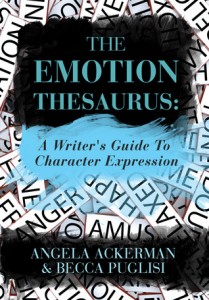 We’ve all heard about showing instead of telling. It’s one of the things my editor catches me on all the time. I end up grousing and repeating the words of
We’ve all heard about showing instead of telling. It’s one of the things my editor catches me on all the time. I end up grousing and repeating the words of Princes Leia Carrie Fisher from When Harry Met Sally. “You’re right. You’re right. I know you’re right.”
Check out this example:
Anger filled Danny as he strode through the room. He was looking for Shiv. If he ever found his friend, he’d give him a piece of his mind.
There’s a lot of telling about Danny’s emotions in that paragraph. To make the storytelling more interesting, I’m going to turn to The Emotion Thesaurus: A Writer’s Guide to Character Expression by Angela Ackerman and Becca Puglisi.
The Emotion Thesaurus is a wonderful reference book that’s organized by emotions like amazement, confidence, gratitude, and shame. Each entry has a long list of behavioral cues authors can use to show instead of tell.
When I look up anger in The Emotion Thesaurus I see lists of 36 physical signals like “flaring nostrils”, “Slamming doors, cupboards, or drawers”, and “laughter with an edge”. After that is a list of internal sensations, mental responses, and cues of suppressed anger. All of these offer inspiration to unlock ideas of how I can show my character’s anger.
How about this:
Chin held high and jaw clenched, Danny shouldered through the crowd. He scanned through the room for Shiv. Curses boiled in his mind, building and building in pressure. The only thing that kept him from punching one of these idiots was knowing how happy Shiv would be to see him get thrown in jail for battery.
I built this new version by consulting The Emotion Thesaurus. I didn’t use the entries word for word. Instead, I riffed on them, used them for inspiration.
Check out The Emotion Thesaurus at Amazon.com or Barnes and Noble.



